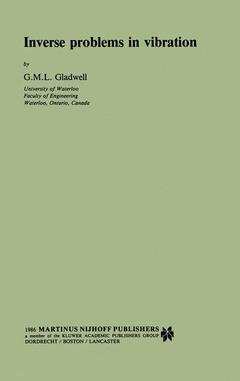Inverse problems in vibration, Softcover reprint of the original 1st ed. 1986 Coll. Mechanics: Dynamical Systems, Vol. 9
Langue : Français
Auteur : Gladwell G.M.L.

The last thing one settles in writing a book is what one should put in first. Pascal's Pensees Classical vibration theory is concerned, in large part, with the infinitesimal (i. e. , linear) undamped free vibration of various discrete or continuous bodies. One of the basic problems in this theory is the determination of the natural frequencies (eigen frequencies or simply eigenvalues) and normal modes of the vibrating body. A body which is modelled as a discrete system' of rigid masses, rigid rods, massless springs, etc. , will be governed by an ordinary matrix differential equation in time t. It will have a finite number of eigenvalues, and the normal modes will be vectors, called eigenvectors. A body which is modelled as a continuous system will be governed by a partial differential equation in time and one or more spatial variables. It will have an infinite number of eigenvalues, and the normal modes will be functions (eigen functions) of the space variables. In the context of this classical theory, inverse problems are concerned with the construction of a model of a given type; e. g. , a mass-spring system, a string, etc. , which has given eigenvalues and/or eigenvectors or eigenfunctions; i. e. , given spec tral data. In general, if some such spectral data is given, there can be no system, a unique system, or many systems, having these properties.
1 — Elementary Matrix Analysis.- 1.1 Introduction.- 1.2 Basic definitions and notations.- 1.3 Matrix inversion and determinants.- 1.4 Eigenvalues and eigenvectors.- 2 — Vibration of Discrete Systems.- 2.1 Introduction.- 2.2 Vibration of some simple systems.- 2.3 Transverse vibration of a beam.- 2.4 Generalized coordinates and Lagrange’s equations.- 2.5 Natural frequencies and normal modes.- 2.6 Principal coordinates and receptances.- 2.7 Rayleigh’s Principle.- 2.8 Vibration under constraint.- 2.9 Iterative and independent definitions of eigenvalues.- 3 — Jacobian Matrices.- 3.1 Sturm sequences.- 3.2 Orthogonal polynomials.- 3.3 Eigenvectors of Jacobian matrices.- 4 — Inversion of Discrete Second-Order Systems.- 4.1 Introduction.- 4.2 An inverse problem for a Jacobian matrix.- 4.3 Variants of the inverse problem for a Jacobian matrix.- 4.4 Inverse eigenvalue problems for spring-mass system.- 5 — Further Properties of Matrices.- 5.1 Introduction.- 5.2 Minors.- 5.3 Further properties of symmetric matrices.- 5.4 Perron’s theorem and associated matrices.- 5.5 Oscillatory matrices.- 5.6 Oscillatory systems of vectors.- 5.7 Eigenvalues of oscillatory matrices.- 5.8 u-Line analysis.- 6 — Some Applications of the Theory of Oscillatory Matrices.- 6.1 The inverse mode problem for a Jacobian matrix.- 6.2 The inverse problem for a single mode of a spring-mass system.- 6.3 The reconstruction of a spring-mass system from two modes.- 6.4 A note on the matrices appearing in a finite element model of a rod.- 7 — The Inverse Problem for the Discrete Vibrating Beam.- 7.1 Introduction.- 7.2 The eigenanalysis of the clamped-free beam.- 7.3 The forced response of the beam.- 7.4 The spectra of the beam.- 7.5 Conditions of the data.- 7.6 Inversion by using orthogonality.- 7.7 The block-Lanczos algorithm.- 7.8 A numerical procedure for the beam inverse problem.- 8 — Green’s Functions and Integral Equations.- 8.1 Introduction.- 8.2 Sturm-Liouville systems.- 8.3 Green’s functions.- 8.4 Symmetric kernels and their eigenvalues.- 8.5 Oscillatory properties of Sturm-Liouville kernels.- 8.6 Completeness.- 8.7 Nodes and zeros.- 8.8 Oscillatory systems of functions.- 8.9 Perron’s theorem and associated kernels.- 8.10 The interlacing of eigenvalues.- 8.11 Asymptotic behaviour of eigenvalues and eigenfunctions.- 8.12 Impulse responses.- 9 — Inversion of Continuous Second-Order Systems.- 9.1 Introduction.- 9.2 A historical overview.- 9.3 The reconstruction procedure.- 9.4 The Gel’fand-Levitan integral equation.- 9.5 Reconstruction of the differential equation.- 9.6 The inverse problem for the vibrating rod.- 9.7 Reconstruction from the impulse response.- 10 — The Euler-Bernoulli Beam.- 10.1 Introduction.- 10.2 Oscillatory properties of Euler-BernouUi kernels.- 10.3 The eigenfunctions of the cantilever beam.- 10.4 The spectra of the beam.- 10.5 Statement of the inverse problem.- 10.6 The reconstruction procedure.- 10.7 The positivity of matrix P is sufficient.- 10.8 Determination of feasible data.
Date de parution : 06-2012
Ouvrage de 284 p.
15.5x23.5 cm
Disponible chez l'éditeur (délai d'approvisionnement : 15 jours).
Prix indicatif 52,74 €
Ajouter au panierThème d’Inverse problems in vibration :
Mots-clés :
© 2024 LAVOISIER S.A.S.
